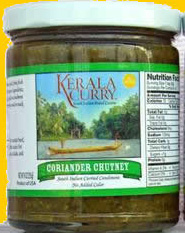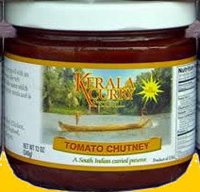

They don’t look familiar, they don’t taste familiar. But they”ll do wonderful things for your cuisine.
|
Caitlin Barrett is a member of The Nibble editorial staff.
|
|
October 2005
|
 |
Kerala Curry Chutneys
Condiments From The East Grace Foods From The West
The word chutney comes from the Hindi word catni (pronounced “chat-nee”), meaning “to taste.” Definitions in food dictionaries vary, from “spicy, marmalade-like condiment” to “relish made of chopped fruits or green tomatoes cooked in vinegar and sugar with ginger and spices.” That’s because there are both sweet and savory chutneys, though many American’s are familiar with only sweet mango chutneys like Major Gray’s. And anyway, written definitions are unimportant when you are tasting products from Kerala Curry. They define their chutneys through their high-quality taste.
Kerala Curry’s chutneys contain the secret to a better meal. The recipes come from owner Ann Varkey’s ancestors. She preserves the traditional flavors of Kerala, the region in southern India from which she and her husband (and co-owner) hail. Her chutneys only use the finest ingredients available, and are free of gluten, MSG, fillers, preservatives and artificial colors.
While Kerala makes a number of flavors, there are two we think must be tried by anyone looking for new and exciting flavors:
- Tomato Chutney. This chutney is as sweet and smooth as ordinary ketchup, but cumin, ginger, red chili powder and the Kerala spice blend bring this sauce to a level of savory complexity rarely achieved by any condiment. It is our new favorite burger topping.
- Coriander Chutney. If you’ve never had coriander chutney, you don’t know what you’re missing. Spread it on sandwiches (great with turkey, ham, roast beef), with or without mayo, add it to yogurt for dips, use it to coat lamb (or as a condiment on the side. It’s spicy, but fresh coriander, green chili pepper and cumin enliven anything they touch.
When we first tried these Indian condiments, we were amazed at their versatility. Our first reaction to the Tomato Chutney was: a great substitute for spicy ketchup. Rather than treat them like as something exotic and inaccessible, we wanted to find a way to use them in everyday cooking. In addition to the uses above:
- Make instant dips by stirring some into yogurt, mayonnaise, or a combination of the two.
- The same “dip” can be repurposed onto mini papadums as hors d’oeuvres.
- Use them as dipping sauces for cocktail sausages, meatballs and wings.
- Use the vivid colors as a combined plate decoration/garnish (chutneys are traditionally used as a side relish for meat, poultry, fish and rice...and you can use them with any American preparation).
- Tomato is a suggested condiment for roasted beef, chicken, pork, and lamb; and as a table sauce for seafood, steamed/boiled vegetables, sandwiches, burgers, and barbecue.
- Coriander works with the same, and also can be used to enhance pizza and salads.
They’re both fat-free and low calorie: coriander is 10 calories a tablespoon and tomato is 20 calories.
You know without being told that these chutneys are handmade with the finest ingredients in small batches. The quality is unsurpassed by any others we’ve had. We doubt we could reproduce the flavor of these chutneys in our own kitchen, no matter how hard we tried. That’s why we’ll keep coming back for more!
KERALA CURRY
Coriander Chutney and Tomato Chutney
- 9-Ounce Jar
$4.29 Average Retail Price
Purchase at Southern Season, The Fresh Market, Lowes Foods and Whole Foods (in North Carolina only) and other specialty retailers.
For more information, visit KeralaCurry.com
Shipping and tax additional. Prices are verified at publication but are subject to change.
|

|
 |

|




